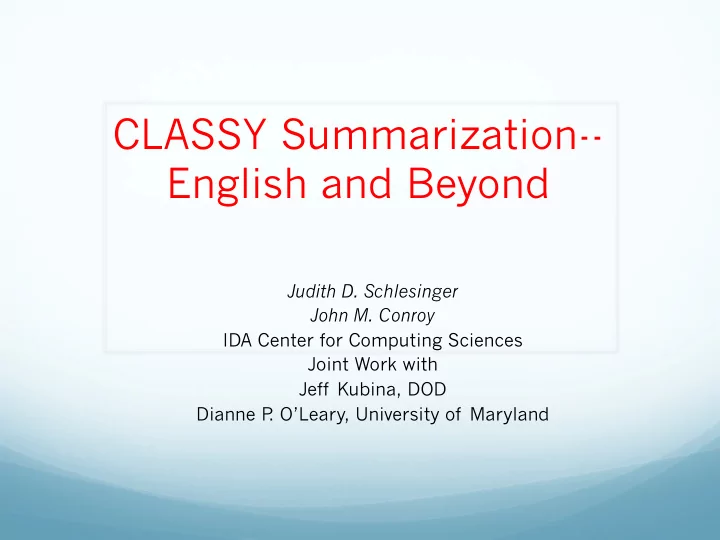

CLASSY Summarization-- English and Beyond Judith D. Schlesinger John M. Conroy IDA Center for Computing Sciences Joint Work with Jeff Kubina, DOD Dianne P . O’Leary, University of Maryland
Overview • Linguistic Processing – Guided Summarization – Multi-lingual Summarization – Future Tasks • Scoring and Selection – Guided Summarization – Multi-lingual Summarization – Future Tasks
Guided Summarization Linguistic Processing • Tasks • Classify sentences: -1, 0, 1 • Sentence split: FASST-E • Tokenize and trim • Query term generation
Guided Summarization Linguistic Processing (cont.) • Basically very stable – Changing only to correct errors or to handle new situations • But … – Error in “clean” data – Others
Multi-lingual Summarization Linguistic Processing • New: 2 variations for other languages – Based on FASST-E – upper/lower case alphabets; single case only – Growing pain errors • Missed splits after numbers • New formats...new problems – Datelines, including English – Catch-22 on how to handle
Linguistic Processing Future Tasks • Strengthen non-English sentence splitters – 2 nd pass for datelines, quotes, short sentences, etc. • Non-English trimming – Lead phrases – Other trims???? • English: Anaphora resolution
Questions???
• Examples of new dateline formats – Tuesday, July 18, 2005 – Meadow Lake, Saskatchewan -- – On same line as following text
Human Summary Space P ( t | τ ) Cluster of τ Probability that a human Docs will include term t in a τ summary on topic and an estimate. P ( t | τ ) ˆ
General Recipe 1. Estimate probability that a term (bigram) will be included by a human. 2. Optionally project term sentence matrix to be orthogonal to previously generated summary. 3. Select a non-redundant subset of sentences with high density of terms likely chosen by a human. 4. Order the sentences to improve flow (approximate TSP).
Submission 25 qs ρ ( t | τ ) = α q q ( t ) + α s s ( t ) + α ρ ρ ( t ) P ⎧ ⎪ 1 if t is a signature [query] term s ( t )[ q ( t )] = ⎨ 0 if t is not a signature [query] term ⎪ ⎩ ρ ( t | τ ) = probability t occurs in a sentence considered for selection. Followed by non-negative QR, knapsack to insure 100 words or less, and the approximate TSP to improve flow. Major changes: bigrams and expanded query set. Parameters set optimizing using ROUGE-2 and ROUGE-SU4 as well as nouveu variants for updates.
Submission 42 4 ∑ NB ( t | τ ) = P 4 P ( i i | f 1 , f 2 ) i = 0 P ( i | f 1 , f 2 ) = Bayes posterior prob that i humans would include a term whose features are f 1 and f 2 . Intitial Summaries: 1 = log( p − value used in signature term computation A f 1 2 = TextRank of term t . f A B / f 2 1 = log( f 2 Update Summaries: f B A ). Low scoring non-query terms removed to compute TextRank. Followed by non-negative QR, knapsack to insure 100 words or less, and an approximate TSP to improve flow. Major changes: bigrams and expanded query set. Trained on TAC 2010 using naïve Bayes, normal approximation.
Results Submission Resp. Pyr. Read. ROUGE-2 Rank (#humans beat) 25 Set A 1 10 6 3 (7) 25 Set B 3 4 2 2 (4) 42 Set A 18 28 9 9 (5) 42 Set B 17 26 9 15 (1)
A View of the Results
View of the Update Results
Multi-lingual Task Goal: Develop a language independent summarizer. Approach: 1. Collect a background model for each target language(Wiki news). 2. Compute language independent features. 3. Train a naïve Bayes classifier on DUC 2005-2007 to compute P NB ( t | τ ) 4. Use binary integer linear program to achieve a maximum covering (better than non-negative QR > 100 words).
Features 1. log( p ) p -value of Dunning (signature term) G-statistic. 2. Sentence TextRank; terms with p -value<0.001 are included. (Auto-stop list.) 3. log( P ( t j | S 0 )); log probability that a term occurs in a sentence in the cluster of documents to be summarized. 4. log( P ( t j | S 1 )); log probability that a term occurs in a sentence with 1 or more signature term in the cluster of documents to be summarized.
Multilingual Results
Things to Do Investigate further why ML failed to do as well. Investigate to what extent current features are language independent. Further use of pairwise testing to determine best approach. (See Peter Rankel’s talk.)
Recommend
More recommend